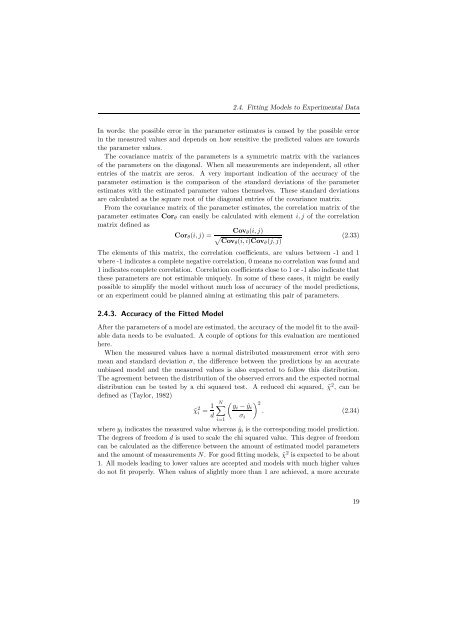Corynebacterium glutamicum - JUWEL - Forschungszentrum Jülich
Corynebacterium glutamicum - JUWEL - Forschungszentrum Jülich
Corynebacterium glutamicum - JUWEL - Forschungszentrum Jülich
You also want an ePaper? Increase the reach of your titles
YUMPU automatically turns print PDFs into web optimized ePapers that Google loves.
2.4. Fitting Models to Experimental Data<br />
In words: the possible error in the parameter estimates is caused by the possible error<br />
in the measured values and depends on how sensitive the predicted values are towards<br />
the parameter values.<br />
The covariance matrix of the parameters is a symmetric matrix with the variances<br />
of the parameters on the diagonal. When all measurements are independent, all other<br />
entries of the matrix are zeros. A very important indication of the accuracy of the<br />
parameter estimation is the comparison of the standard deviations of the parameter<br />
estimates with the estimated parameter values themselves. These standard deviations<br />
are calculated as the square root of the diagonal entries of the covariance matrix.<br />
From the covariance matrix of the parameter estimates, the correlation matrix of the<br />
parameter estimates Corθ can easily be calculated with element i, j of the correlation<br />
matrix defined as<br />
Corθ(i, j) =<br />
Covθ(i, j)<br />
� Covθ(i, i)Covθ(j, j)<br />
(2.33)<br />
The elements of this matrix, the correlation coefficients, are values between -1 and 1<br />
where -1 indicates a complete negative correlation, 0 means no correlation was found and<br />
1 indicates complete correlation. Correlation coefficients close to 1 or -1 also indicate that<br />
these parameters are not estimable uniquely. In some of these cases, it might be easily<br />
possible to simplify the model without much loss of accuracy of the model predictions,<br />
or an experiment could be planned aiming at estimating this pair of parameters.<br />
2.4.3. Accuracy of the Fitted Model<br />
After the parameters of a model are estimated, the accuracy of the model fit to the available<br />
data needs to be evaluated. A couple of options for this evaluation are mentioned<br />
here.<br />
When the measured values have a normal distributed measurement error with zero<br />
mean and standard deviation σ, the difference between the predictions by an accurate<br />
unbiased model and the measured values is also expected to follow this distribution.<br />
The agreement between the distribution of the observed errors and the expected normal<br />
distribution can be tested by a chi squared test. A reduced chi squared, ˜χ 2 ,canbe<br />
defined as (Taylor, 1982)<br />
˜χ 2 i = 1<br />
d<br />
N�<br />
� �2 yi − ˆyi<br />
. (2.34)<br />
i=1<br />
where yi indicates the measured value whereas ˆyi is the corresponding model prediction.<br />
The degrees of freedom d is used to scale the chi squared value. This degree of freedom<br />
can be calculated as the difference between the amount of estimated model parameters<br />
and the amount of measurements N. For good fitting models, ˜χ 2 is expected to be about<br />
1. All models leading to lower values are accepted and models with much higher values<br />
do not fit properly. When values of slightly more than 1 are achieved, a more accurate<br />
σi<br />
19

















